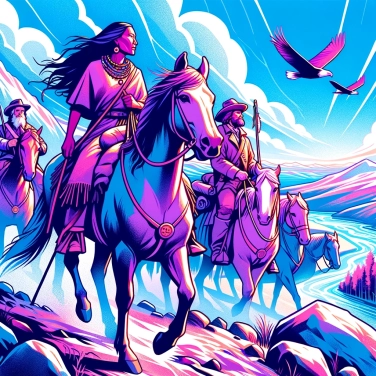Sacagawea was a crucial guide for the Lewis and Clark expedition because she knew the terrain, indigenous languages, and had essential knowledge in herbalism, helping the expedition navigate, communicate, and feed themselves during their journey across the American West.

Sacagawea spoke several languages, including Shoshone and Hidatsa, which allowed Lewis and Clark to communicate clearly and avoid delicate misunderstandings with the tribes they encountered. Her cultural heritage was also invaluable: she was well-versed in indigenous customs, helping to create an atmosphere of respect and trust during meetings. Thanks to her knowledge, the expedition was able to form useful alliances with local populations more easily. She often served as an interpreter, first translating from Shoshone to Hidatsa, then into French through her husband Toussaint Charbonneau, so that another member could finally translate into English for Lewis and Clark. Despite this lengthy process, without her, establishing a dialogue would have been nearly impossible. Her presence greatly facilitated the intercultural understanding essential for the success of the expedition.
Sacagawea primarily represented a clear sign of peace in the eyes of the tribes encountered by Lewis and Clark. Seeing a woman accompanied by a baby immediately reassured the natives about the peaceful intentions of the group. She regularly intervened during exchanges with Native American leaders, easing tensions or misunderstandings thanks to her knowledge of local customs. Sacagawea knew how to facilitate communication, often preventing unnecessary conflicts with her skills as a mediator. She helped ensure safety and tranquility within the expedition by quickly establishing a climate of trust with the indigenous communities.
Sacagawea had an incredible visual memory of landscapes, waterways, and natural paths, knowledge she had acquired during her childhood with the Shoshones. Thanks to her, Lewis and Clark identified the right mountain passes, found safe routes through unknown valleys, and often avoided dangerous detours. She perfectly recognized natural landmarks, such as certain mountain peaks or specific waterways, thus preventing the expedition from getting lost. Without her, they would have wasted a lot of time and faced significant risks while crossing unknown and sometimes outright hostile territories.
Sacagawea was very knowledgeable about local medicinal plants: she knew exactly which ones to use to heal wounds, relieve pain, or fight fever. She also indicated to the explorers which edible roots could be safely consumed, helping them find food when it was scarce. Thanks to her knowledge, the expedition was able to survive more easily in wilderness areas they were completely unfamiliar with. She was able to quickly locate where the useful plants were, making their daily life significantly less difficult.
Sacagawea quickly won the admiration of the group due to her calm demeanor and courage. Her presence with a newborn throughout the expedition reassured the explorers, giving them confidence in the face of the indigenous peoples they encountered: seeing a mother with her child was seen as a sign of peace. Everyone also noticed her unwavering determination in the face of difficulties, clearly boosting team spirit. Her kindness and subtle humor often improved the atmosphere, transforming a tough and uncertain journey into a more human and less stressful adventure.
Sacagawea was only about 16 years old when she joined the Lewis and Clark expedition as an interpreter and guide. Despite her young age, her courage and knowledge were essential to the success of the journey.
In February 1805, Sacagawea saved valuable supplies from the expedition, including important travel journals, when their boat capsized on the Missouri River. Her quick reaction helped preserve essential historical documents.
Sacagawea belonged to the Shoshone tribe. When she reunited with her brother, Cameahwait, the chief of a Shoshone community, it allowed Lewis and Clark to obtain essential horses to cross the difficult Rocky Mountains.
Her baby, Jean-Baptiste Charbonneau, nicknamed 'Pomp', traveled the entire Lewis and Clark expedition on his mother's back. He was therefore the youngest member of this famous historical exploration mission.
Sacagawea was crucial in overcoming language barriers, facilitating negotiations for passage through Indigenous territories, and identifying essential food and medicinal resources in unfamiliar terrain.
No, at that time, the importance of Sacagawea had not been fully recognized or officially documented. It was only later, through extensive historical research, that her crucial role in the success of the expedition was acknowledged and highlighted.
Sacagawea often served as a cultural intermediary, inspiring trust and easing tensions during encounters with Indigenous tribes that were unfamiliar with Lewis and Clark. Her mere presence as a woman accompanied by a child often signaled a peaceful intent of the expedition.
Historical sources vary, but it is commonly accepted that Sacagawea passed away around 1812. However, some traditions claim that she lived to an old age among the Shoshones. Her life after the expedition remains shrouded in mystery and historical controversy.
Sacagawea was a Lemhi Shoshone woman who played a crucial role in the Lewis and Clark Expedition (1804-1806). She served as an interpreter, guide, and cultural mediator between the expedition and the Indigenous tribes they encountered.

No one has answered this quiz yet, be the first!' :-)
Question 1/6